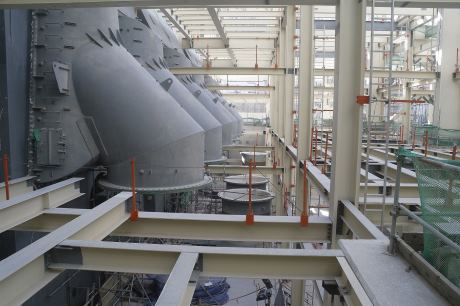The final condenser at the United Arab Emirates' Barakah nuclear power plant has been installed, the Emirates Nuclear Energy Corporation (Enec) announced today. The condenser cools the steam produced in the reactor's steam generators back into water after it has been used to spin the plant's generator turbine.
 |
| Barakah 4's condenser (Image: Enec) |
Condensers are a vital component of all power plants that use steam to spin a turbine, not just nuclear plants. The condenser installed at Barakah unit 4 is one of the largest in the Middle East region.
Barakah's condensers are designed to suit the environmental conditions of the Arabian Gulf, where the plant is located. The UAE's Federal Authority for Nuclear Regulation stipulates that the temperature of the plant's discharge water must not be more than 5 degrees Celsius above the ambient temperature of the Gulf. Barakah's condensers take in seawater which is mixed with the cooling water to ensure this is achieved. About 6000 cubic metres of sea water per minute will pass through the condenser's 85,000 titanium and stainless steel tubes when the plant is generating electricity.
The condenser installed at Barakah 4 was manufactured in South Korea and shipped in three sections, each weighing 700 tonnes and 27 metres in length. The condenser was then assembled in the open, next to the unit's turbine building.
Similar work was completed at Barakah's other three units between 2014 and 2016. Enec CEO Mohamed Al Hammadi said completion of the final installation demonstrated the "smooth sequencing" of construction work that demonstrated the benefits of building four identical units simultaneously.
Construction work on Barakah 4's turbine building will be completed over the next few months, and the unit is now more than 38% complete, Enec said.
Four Korean-designed APR1400 reactors are under construction at Barakah, in western Abu Dhabi. The plant is being built for Enec by a consortium led by the Korean Electric Power Company and is now around 76% complete. The first unit is expected to start up later this year, with the other units following at roughly one-year intervals.
Researched and written
by World Nuclear News




_47120.jpg)
_23621.jpg)

_63865.jpg)





